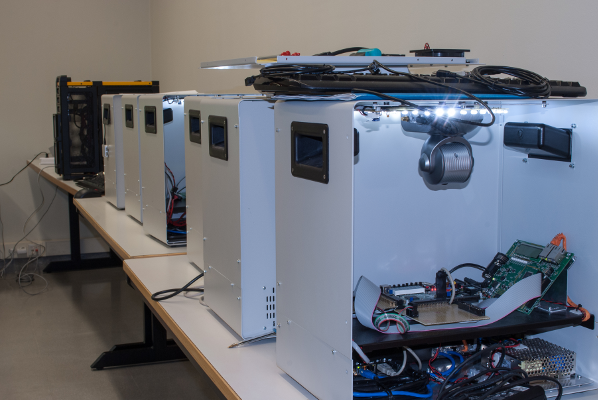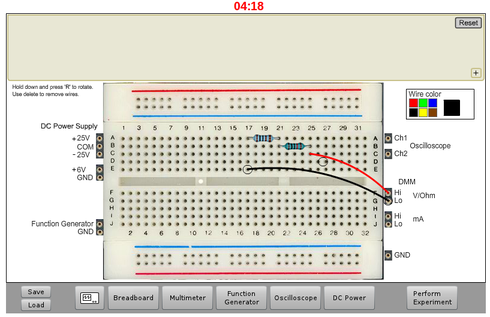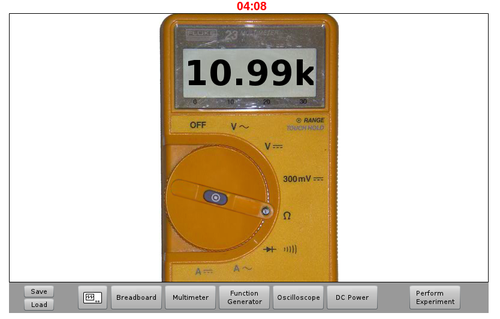This is a selection of the laboratories available in the University of Deusto.
The Robot lab lets you program the bot yourself, with any program you wish.
The bot uses an Arduino microcontroller, so the program should be written using Arduino. It is noteworthy that the bot has, among other things, infrared sensors, to which the developer has access.

Target audience: engineering students in general, certain secondary schools.
The FPGA laboratory lets you remotely practise with a Field Programmable Gate Array (FPGA). Through the Xilinx software, you can write a FPGA program locally as you normally would. Once the program is compiled, and ready to be tested, you should simply upload the binary ”.bit” file through the experiment.
ud-fpga will automatically program the FPGA board with the binary you provided, and start running it. To see the results, a Webcam is of course provided. You may also interact with the board remotely, by using the provided widgets. Though the widgets themselves might appear artificial, they will send a signal to the board just like their physical counterparts would.
However, due to certain safety concerns, in the demo version you can't upload your own file for this demo. Instead, a specific demo program (which has already been uploaded) will be used. Everything else will work as in the standard FPGA experiment.

The FPGA laboratory, as other WebLab-Deusto laboratories (PIC or CPLD), is developed within the WebLab-Box. On the WebLab-Box, the device, as well as a fit-pc, a PIC microcontroller, a camera, lighting system and networking materials is installed, so as to make it easier to create and deploy new laboratories.
Target audience: Electronics Engineering students.
The aquarium laboratory creates an access to a real aquarium located in the University of Deusto. On it, it is possible to feed the fish, turn on and off the lights, and, if the submarine is in the water and it is charged, control the submarine. The problem is that most of the time, the submarine is out of battery so we only put it in the fishtank certain days.
Regarding feeding the fish, it may seem dangerous, but it is not. The system feeds them automatically three times a day, every 8 hour. If a user feeds them, then it does not let any other user to feed them before the next shift, guaranteeing that they are only fed three times. So go ahead and try it!
The initial rationale behind this laboratory is that groups of primary school students are responsible of the life of these fish (even if they are not under a real danger). Teachers may know which groups of students have feed them correctly, which students didn’t forget and which students coordinated correctly so no one overfed the fish.
However, at the time of this writing ongoing work is being done for adding more sensors to this laboratory, so stay tuned ;-)

Target audience: initially, primary school students. Right now the focus is changing to take into account physics principles with sensors.
BTH OpenLabs VISIR (Virtual Instrument Systems In Reality) is a Remote Laboratory developed in the Blekinge Institute of Technology, which supports remote experimentation with real electronic circuits.
Students create circuits using the web interface, such as the following (where two resistors, of 10k and 1k are placed in serial and connected to the Digital MultiMeter):

And as a result of this, the digital multimeter will show the sum of the two resistors:

Target audience: It depends on how many principles are taught. It has been used with secondary school students, as well as with electronics engineering courses.
These laboratories are not developed in the University of Deusto. For further information, you should contact Martin Kalúz ( martin.kaluz [at] stuba.sk).
Provided remote labs are based on unified hardware architecture of industrial aimed devices including programmable logic controllers (PLC) and industrial network routers (INR) eWON4005cd. This multipurpose hardware architecture (MHA) is designed for controlling remote equipment in term of signal control, therefore the overall physical setup allows developers to include any experimental device that can be physically connected to PLC. While PLCs are used as base control unit, INR provides the supervision layer for single or several experimental nodes (PLC + experimental device) over local area network within physical laboratories of institute.
